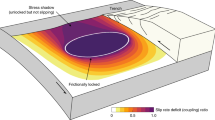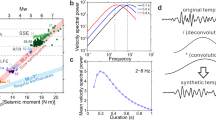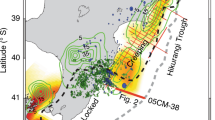Abstract
At subduction zones, the level of friction on the deep part of the plate boundary fault controls stress accumulation and release, which govern the transfer of stress to the shallower, locked part of the fault that can slip in a megathrust earthquake. In some subduction zones, the deep fault slips slowly, at speeds far less than shallower, regular earthquakes, and is often accompanied by weak seismic waves called tremor. Tremor and slow slip can be triggered by small stress changes induced by ocean or solid Earth tides. Here I use seismic data combined with calculations of tidal stress to determine the influence of tides on 31,000 tremors generated by six large slow-slip events in Cascadia between 2007 and 2012. I find that the sensitivity of tremor to tidal stresses rises during each slip event, as slip at each spot on the fault accumulates. Specifically, tremor rate is an exponential function of tidal stress, and this exponential sensitivity grows for several days, implying that the fault weakens during slip. I use the relationship between tidal stress and tremor to calculate a coefficient of intrinsic friction for the fault and find values of 0 to 0.1, which indicate that the deep fault is inherently weak.
This is a preview of subscription content, access via your institution
Access options
Subscribe to this journal
Receive 12 print issues and online access
$259.00 per year
only $21.58 per issue
Buy this article
- Purchase on Springer Link
- Instant access to full article PDF
Prices may be subject to local taxes which are calculated during checkout





Similar content being viewed by others
References
Obara, K. Nonvolcanic deep tremor associated with subduction in southwest Japan. Science 296, 1679–1681 (2002).
Rogers, G. & Dragert, H. Episodic tremor and slip on the Cascadia subduction zone: The chatter of silent slip. Science 300, 1942–1943 (2003).
Ide, S., Beroza, G., Shelly, D. & Uchide, T. A scaling law for slow earthquakes. Nature 447, 76–79 (2007).
Houston, H., Delbridge, B., Wech, A. & Creager, K. Rapid tremor reversals in Cascadia generated by a weakened plate interface. Nature Geosci. 4, 404–409 (2011).
Rubin, A. Designer friction laws for bimodal slow slip propagation speeds. Geochem. Geophys. Geosyst. 12, Q04007 (2011).
Shelly, D., Beroza, G. & Ide, S. Non-volcanic tremor and low-frequency earthquake swarms. Nature 446, 305–307 (2007).
Hirose, H. & Obara, K. Short-term slow slip and correlated tremor episodes in the Tokai region, central Japan. Geophys. Res. Lett. 33, L17311 (2006).
Dragert, H., Wang, K. L. & James, T. S. A silent slip event on the deeper Cascadia subduction interface. Science 292, 1525–1528 (2001).
Nishimura, T., Matsuzawa, T. & Obara, K. Detection of short-term slow slip events along the Nankai Trough, southwest Japan, using GNSS data. J. Geophys. Res. 118, 3112–3125 (2013).
Hirose, H. & Obara, K. Repeating short- and long-term slow slip events with deep tremor activity around the Bungo Channel region, southwest Japan. Earth Planets Space 57, 961–972 (2005).
Miyazaki, S., Segall, P., McGuire, J. J., Kato, T. & Hatanaka, Y. Spatial and temporal evolution of stress and slip rate during the 2000 Tokai slow earthquake. J. Geophys. Res. 111, B03409 (2006).
McCaffrey, R., Wallace, L. M. & Beavan, J. Slow slip and frictional transition at low temperature at the Hikurangi subduction zone. Nature Geosci. 1, 316–320 (2008).
Ozawa, S., Suito, H. & Tobita, M. Occurrence of quasi-periodic slow-slip off the east coast of the Boso Peninsula, Central Japan. Earth Planets Space 59, 1241–1245 (2007).
Brudzinski, M. R. & Allen, R. M. Segmentation in episodic tremor and slip all along Cascadia. Geology 35, 907–910 (2007).
Houston, H. Influence of depth, focal mechanism, and tectonic setting on the shape and duration of earthquake source time functions. J. Geophys. Res. 106, 11137–11150 (2001).
Rubinstein, J., La Rocca, M., Vidale, J., Creager, K. & Wech, A. Tidal modulation of nonvolcanic tremor. Science 319, 186–189 (2008).
Nakata, R., Suda, N. & Tsuruoka, H. Non-volcanic tremor resulting from the combined effect of Earth tides and slow slip events. Nature Geosci. 1, 676–678 (2008).
Lambert, A., Kao, H., Rogers, G. & Courtier, N. Correlation of tremor activity with tidal stress in the northern Cascadia subduction zone. J. Geophys. Res. 114, B00A08 (2009).
Thomas, A., Nadeau, R. & Burgmann, R. Tremor-tide correlations and near-lithostatic pore pressure on the deep San Andreas Fault. Nature 462, 1048–1051 (2009).
Hawthorne, J. & Rubin, A. Tidal modulation of slow slip in Cascadia. J. Geophys. Res. 115, B007502 (2010).
Thomas, T. et al. Evidence for tidal triggering of high-amplitude rapid tremor reversals and tremor streaks in northern Cascadia. Geophys. Res. Lett. 40, 4254–4259 (2013).
Wech, A. G. & Creager, K. C. Automated detection and location of Cascadia tremor. Geophys. Res. Lett. 35, L20302 (2008).
Sweet, J. R. Unlocking the secrets of slow slip in Cascadia using low-frequency earthquakes. PhD thesis, Univ. Washington (2014)
Royer, A. A., Thomas, A. M. & Bostock, M. G. Tidal modulation and triggering of low-frequency earthquakes in northern Cascadia. J. Geophys. Res. 120, 384–405 (2015).
Beeler, N. M., Thomas, A., Burgmann, R. & Shelly, D. Inferring fault rheology from low-frequency earthquakes on the San Andreas. J. Geophys. Res. 118, 5976–5990 (2013).
Beeler, N. M., Simpson, R. W., Hickman, S. H. & Lockner, D. A. Pore fluid pressure, apparent friction, and Coulomb failure. J. Geophys. Res. 105, 25533–25542 (2000).
Cocco, M. & Rice, J. Pore pressure and poroelasticity effects in Coulomb stress analysis of earthquake interactions. J. Geophys. Res. 107, 2030 (2002).
Paterson, M. S. & Wong, T-f. Experimental Rock Deformation—The Brittle Field 2nd edn (Springer, 2005).
Ingebritsen, S. E. & Manning, C. E. Permeability of the continental crust: Dynamic variations inferred from seismicity and metamorphism. Geofluids 10, 193–205 (2010).
Sone, H., Shimamoto, T. & Moore, D. E. Frictional properties of saponite-rich gouge from a serpentinite-bearing fault zone along the Gokasho-Arashima Tectonic Line, central Japan. J. Struct. Geol. 38, 172–182 (2012).
Audet, P., Bostock, M. G., Christensen, N. I. & Peacock, S. M. Seismic evidence for overpressured subducted oceanic crust and megathrust fault sealing. Nature 457, 76–78 (2009).
Endres, A. L. Geometrical models for poroelastic behaviour. Geophys. J. Int. 128, 522–532 (1997).
Ide, S. & Tanaka, Y. Controls on plate motion by oscillating tidal stress: Evidence from deep tremors in western Japan. Geophys. Res. Lett. 41, 3842–3850 (2014).
Fulton, P. M. et al. Low coseismic friction on the Tohoku-Oki Fault determined from temperature measurements. Science 342, 1214–1217 (2013).
Moore, D. E. & Rymer, M. J. Talc-bearing serpentinite and the creeping section of the San Andreas Fault. Nature 448, 795–797 (2007).
Moore, D. E. & Rymer, M. J. Correlation of clayey gouge in a surface exposure of serpentinite in the San Andreas Fault with gouge from the San Andreas Fault Observatory at Depth (SAFOD). J. Struct. Geol. 38, 51–60 (2012).
Hirauchi, K., den Hartog, S. A. M. & Spiers, C. J. Weakening of the slab-mantle wedge interface induced by metasomatic growth of talc. Geology 41, 75–78 (2013).
Oohashi, K., Hirose, T. & Shimamoto, T. Graphite as a lubricating agent in fault zones: An insight from low- to high-velocity friction experiments on a mixed graphite-quartz gouge. J. Geophys. Res. 118, 2067–2084 (2013).
Schleicher, A. M., van der Pluijm, B. A. & Warr, L. N. Nanocoatings of clay and creep of the San Andreas Fault at Parkfield, California. Geology 38, 667–670 (2010).
Audet, P. & Burgmann, R. Possible control of subduction zone slow-earthquake periodicity by silica enrichment. Nature 510, 389–392 (2014).
McCrory, P., Blair, J., Waldhauser, F. & Oppenheimer, D. Juan de Fuca slab geometry and its relation to Wadati-Benioff zone seismicity. J. Geophys. Res. 117, B009407 (2012).
Shelly, D., Beroza, G., Ide, S. & Nakamula, S. Low-frequency earthquakes in Shikoku, Japan, and their relationship to episodic tremor and slip. Nature 442, 188–191 (2006).
La Rocca, M. et al. Cascadia tremor located near plate interface constrained by S minus P wave times. Science 323, 620–623 (2009).
Kao, H. et al. A wide depth distribution of seismic tremors along the northern Cascadia margin. Nature 436, 841–844 (2005).
Agnew, D. C. NLOADF: A program for computing ocean-tide loading. J. Geophys. Res. 102, 5109–5110 (1997).
Schmidt, D. A. & Gao, H. Source parameters and time-dependent slip distributions of slow slip events on the Cascadia subduction zone from 1998 to 2008. J. Geophys. Res. 115, B00A18 (2010).
Wech, A. G., Creager, K. C. & Melbourne, T. I. Seismic and geodetic constraints on Cascadia slow slip. J. Geophys. Res. 114, B10316 (2009).
Wong, T-f., Wong, R. H. C., Chau, K. T. & Tang, C. A. Microcrack statistics, Weibull distribution and micromechanical modeling of compressive failure in rock. Mech. Mater. 38, 664–681 (2006).
Acknowledgements
I thank J. Hawthorne for assistance with calculations of tidal stresses, S. Ide for suggesting the use of a Weibull distribution, and J. Vidale and K. Creager for helpful suggestions. Reviews from R. Burgmann and the Editor helped improve the paper. This work was supported by NSF grant EAR-1447005.
Author information
Authors and Affiliations
Corresponding author
Ethics declarations
Competing interests
The author declares no competing financial interests.
Supplementary information
Supplementary Information
Supplementary Information (PDF 828 kb)
Rights and permissions
About this article
Cite this article
Houston, H. Low friction and fault weakening revealed by rising sensitivity of tremor to tidal stress. Nature Geosci 8, 409–415 (2015). https://doi.org/10.1038/ngeo2419
Received:
Accepted:
Published:
Issue Date:
DOI: https://doi.org/10.1038/ngeo2419
This article is cited by
-
Weak faults at megathrust plate boundary respond to tidal stress
Earth, Planets and Space (2021)
-
Cascading rupture of patches of high seismic energy release controls the growth process of episodic tremor and slip events
Earth, Planets and Space (2021)
-
Short-term interaction between silent and devastating earthquakes in Mexico
Nature Communications (2021)
-
Geological constraints on the mechanisms of slow earthquakes
Nature Reviews Earth & Environment (2021)
-
An Analytical Microcrack-Based Rock Model with Implications for Earthquake Mechanisms Induced by Stress Changes
Mathematical Geosciences (2021)



